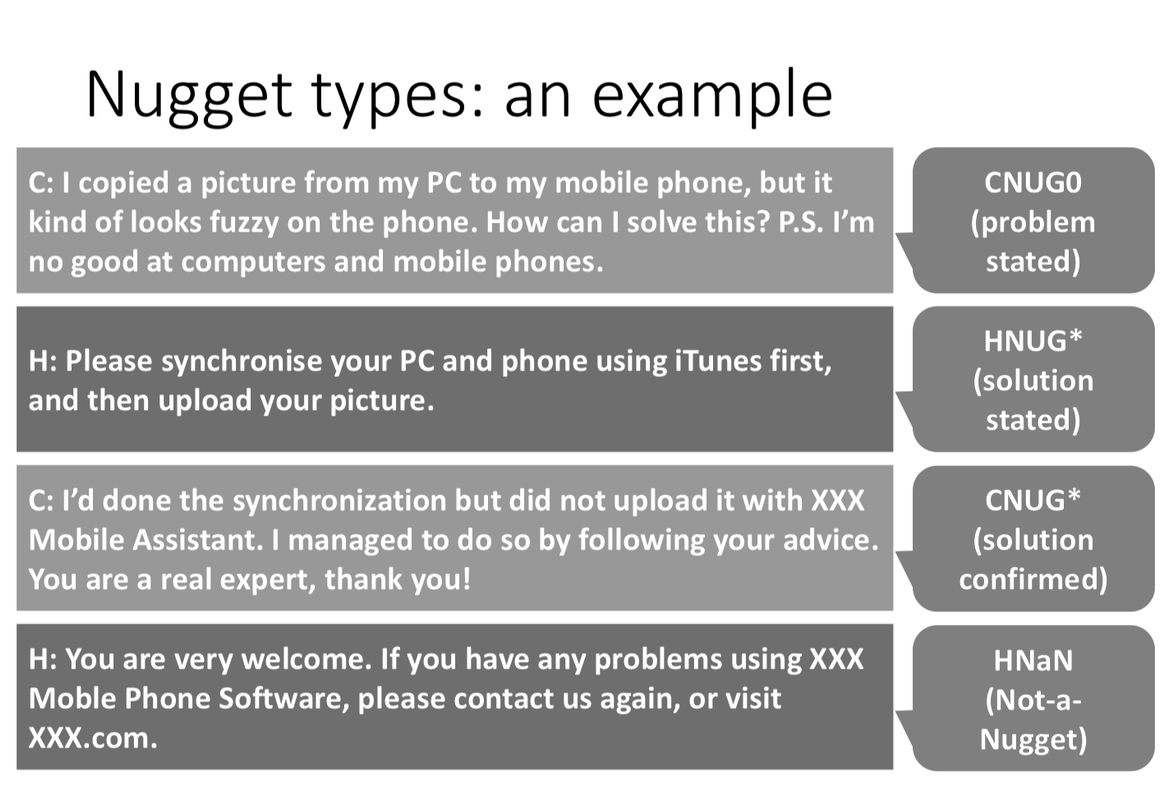Training Data of DialEval-1 Task
Recently, many reserachers are trying to build automatic helpdesk systems. However, there are very few methods to evaluate such systems. In DialEval-1, we aim to explore methods to evaluate task-oriented, multi-round, textual dialogue systems automatically. This dataset have the following features:
- Chinese customer-helpdesk dialogues carwled from Weibo.
- English dialgoues: manually translated from a subset of the Chinese dialgoues.
- Nugget type annotatoins for each turn: indicate whether the current turn is useful to accomplish the task.
- Quality annotation for each dialogue.
- task accomplishment
- customer satisfaction
- dialogue effectiveness
In DialEval-1, we consider annotations ground truth, and participants are required to predict nugget type for each turn (Nugget Detection, or ND) and dialogue quality for each dialogue (Dialogue Quality, or DQ).
Links
Registration
TO and register and obtain the dataset ,please send an email to dialeval1org@list.waseda.jp with the following information so that we can send you the training data.
- Team Name (e.g. Waseda)
- Principal investigator’s name, affilication, email address
- Names, affiliations, email addresses of other team members
- Subtasks that you plan to participate: Chinese, English, or BOTH
Later, NII will require you to register to NTCIR tasks through their website, but please contact us by email first
Leaderboard
Comming Soon
Training Data Overview
The Chinese training dataset contains 4,090 (3,700 for training + 390 for dev) customer-helpdesk dialgoues which are crawled from Weibo. All of these dialogues are annotated by 19 annotators.
The English dataset contains 2, 251 dialogues for training + 390 for dev. They are manually translated from a subset of the Chinese dataset. The English dataset shares the same annotations with the Chinese dataset.
- Training set
- train_cn.json (3,700 Chinese dialogues)
- train_en.json (2, 251 English dialogues)
- Dev set
- dev_cn.json (390 dialogues)
- dev_en.json (390 dialogues)
Annotators
We hired 19 Chinese students from the department of Computer Science, Waseda University to annotate this dataset.
Format of the JSON file
Each file is in JSON format with UTF-8 encoding.
Following are the top-level fields:
- id
- turns: array of turns from the customer and the helpdesk (see details below)
- annotations: a list of annotations provided by 19 annotators. Each annotation consists of two fields: nugget and quality
Each element of the turns field contains the following fields:
- sender: the speaker of this turn (either customer or helpdesk)
- utterances: the utterances (may be multiple) they sent in this turn. Note that some utterances are empty strings since we didn’t crawl emoji and photos.
Each element of annotations contains the following fields:
-
nugget: The list of nugget types for each turn (see details below).
-
quality: A dictonary consists of the subjetive dialogue quality scores: A-score, S-score, and E-score (see details below).
Nugget Types
- CNUG0: Customer trigger (problem stated)
- CNUG*: Customer goal (solution confirmed)
- HNUG*: Helpdesk goal (solution stated)
- CNUG: Customer regular nugget
- HNUG: Helpdesk regular nugget
- CNaN: Customer Not-a-Nugget
- HNaN: Helpdesk Not-a-Nugget

Dialogue Quality
-
A-score: Task Accomplishment (Has the problem been solved? To what extent?)
-
S-score: Customer Satisfaction of the dialogue (not of the product/service or the company)
-
E-score: Dialogue Effectiveness (Do the utterers interact effectively to solve the problem efficiently?)
Scale: [2, 1, 0, -1, -2]
Evaluation
Metrics
During the data annotaiton, we noticed that annotators’ assessment on dialgoues are highly subjective and are hard to consolidate them into one gold label. Thus, we proposed to preserve the diverse views in the annotations “as is” and leverage them at the step of evaluation measure calculation.
Instead of juding whether the estimated label is equal to the gold label, we compare the difference between the estiamted distributions and the gold distributions calculaed by 19 anntators’ annotations). Specifically, we employ these metrics for quality sub-task and nugget sub-task:
- Quality:
- NMD: Normalised Match Distance.
- RSNOD: Root Symmetric Normalised Order-aware Divergence
- Nugget:
- RNSS: Root Normalised Sum of Squared errors
- JSD: Jensen-Shannon divergence
For the details about the metrics, please vistit:
- NTCIR-15 Dialogue Evaluation Task Definition
- Comparing Two Binned Probability Distributions for Information Access Evaluation.
Test and Submission
Comming Soon
Tenative Schedule
Jul 2019 Test data crawling [DONE] Aug-Oct 2019 Adding more English translations to the training data [DONE] Oct 2019 Task registrations open Oct-Dec 2019 Test data annotation Jun 2020 Test data released / Task registrations due Jul 2020 Run submissions due Aug 2020 Evaluation results released Dec 2020 NTCIR-15 Conference at NII, Tokyo, Japan Timezone: Japan (UTC+9)
Have questions?
Please contact: dialeval1org@list.waseda.jp
Conditions and Terms
See https://dialeval-1.github.io/dataset/terms